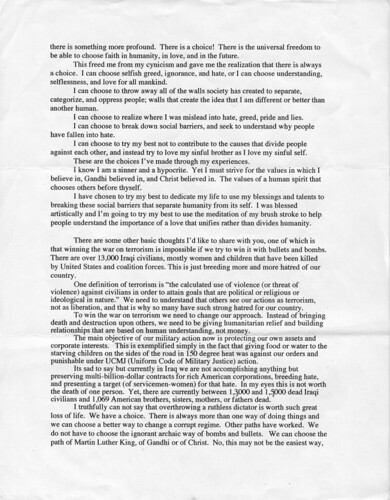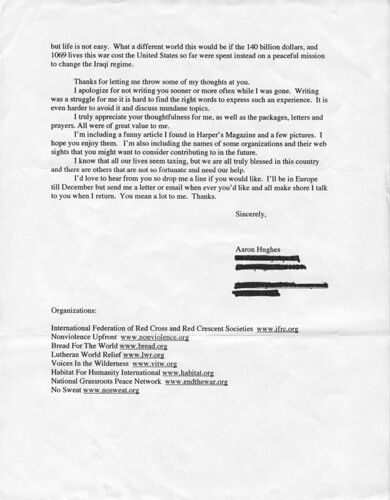What does it mean to develop a creative practice that challenges and critiques the systems that perpetuates dehumanization?
What are the structures that perpetuate dehumanization?
What are the strategies and tactics that directly challenge and critique dehumanization while presenting alternatives?
What does it mean to develop a creative practice that re-humanizes?
What would “art” look if there were no dehumanization?
What would it take for creative practices to function as an agent of re-humanization?
What art would be made if there were no war?
What art would I make if I did not go to Iraq?
What brings people together?
What role does creativity play in that?
What is narrative?
What is meaning?
What does it mean for creative practices to be a link between humanity and meaning?
What is beauty if it is not humanity?
What is trauma?
What are the ways art can order trauma?
What does it mean to behold the sublime?
Is like beholding life? Or love? Or humanity?
What is memory?
What creates memory?
What is freedom?
What does freedom have to do with art?
What does freedom have to do with expression?
In what way does expression communicate humanity?
What is the function of art?
Does it really help?
What does it even mean to help?
What are the ways creative work can unite with the oppressed?
What are the ways creative work can be controlled by the oppressed?
What would the world be like if only the oppressed could tell stories?
What does it take for us humans to value another human?
What does it mean to feel the pain of others?
What does it mean to share the joy of others?
What ways does all this perpetuate the same constructs that got us to this point in history?
What are the ways to destroy history?
What are the ways to destroy oppression?
Does that have anything to do with academia?
What does it mean to be an intellectual and conversely say fuck off to institutions?
What does it mean to say fuck off and fuck you?
What does it take for the world to change?
What is the military?
What are the myths of dehumanization and the military?
What are the myths of art?
What are the myths that I am perpetuating?
What are the ways to be free and share freedom and love?
Monday, January 26, 2009
Edited Statement
What does it mean to develop a creative practice that challenges and critiques the systems that perpetuates dehumanization? What are the structures that perpetuate dehumanization? What are the strategies and tactics that directly challenge and critique dehumanization while presenting alternatives? What does it mean to develop a creative practice that re-humanizes?
The experiments, dreams, concepts, systems, tactics, and strategies that investigate these questions are what make up my practice.
My practice always formally begins with a question and seeks to find better and different questions that can reveille humanity/beauty/the sublime/meaning/love. Formally, the structure of a question is crucial; it avoids an assumed conclusion or answers. Instead it presents a glimpse at an answer while always posing another question.
Currently my practice explores the question, what links narrative to dehumanization and re-humanization. I want to first review the definitions of narrative, dehumanization and re-humanization to begin creating a common ground to build from.
In postmodern theory, semiotics begins with the individual building blocks of meaning called signs — and semantics, the way in which signs are combined into codes to transmit messages. This is part of a general communication system using both verbal and non-verbal elements, and creating a discourse with different modalities and forms.
I will say that these “modalities” and forms can be interpreted as narrative. In other words narrative can be understood as a series of “individual building blocks of meaning” joined.
Narrative’s use of point of view, genres, and fiction and it’s connection to identity, cultural identity, and memory must also be considered but lets start with the idea that narrative is constructed from and constructs meaning.
Dehumanization is a deprivation of constructive human qualities while re-humanization is a assumed reassertion of these constructive qualities. The construction of human qualities is linked to identity, cultural identity, and the construction of meaning. This is where narrative becomes an active participant in dehumanization and re-humanization. This space is also where my creative practice inserts itself to explore the links between narrative and humanity.
I think that it is funny that we are looking at Hayden White to find forms for our practice. I had been looking threw Metahistory as a way to think of narrative and its influence on the construction of meaning.
The experiments, dreams, concepts, systems, tactics, and strategies that investigate these questions are what make up my practice.
My practice always formally begins with a question and seeks to find better and different questions that can reveille humanity/beauty/the sublime/meaning/love. Formally, the structure of a question is crucial; it avoids an assumed conclusion or answers. Instead it presents a glimpse at an answer while always posing another question.
Currently my practice explores the question, what links narrative to dehumanization and re-humanization. I want to first review the definitions of narrative, dehumanization and re-humanization to begin creating a common ground to build from.
In postmodern theory, semiotics begins with the individual building blocks of meaning called signs — and semantics, the way in which signs are combined into codes to transmit messages. This is part of a general communication system using both verbal and non-verbal elements, and creating a discourse with different modalities and forms.
I will say that these “modalities” and forms can be interpreted as narrative. In other words narrative can be understood as a series of “individual building blocks of meaning” joined.
Narrative’s use of point of view, genres, and fiction and it’s connection to identity, cultural identity, and memory must also be considered but lets start with the idea that narrative is constructed from and constructs meaning.
Dehumanization is a deprivation of constructive human qualities while re-humanization is a assumed reassertion of these constructive qualities. The construction of human qualities is linked to identity, cultural identity, and the construction of meaning. This is where narrative becomes an active participant in dehumanization and re-humanization. This space is also where my creative practice inserts itself to explore the links between narrative and humanity.
I think that it is funny that we are looking at Hayden White to find forms for our practice. I had been looking threw Metahistory as a way to think of narrative and its influence on the construction of meaning.
Thursday, January 22, 2009
First Statement
What does it mean to develop a practice that challenges and critiques the systems that perpetuates dehumanization?
This question resides at the core of my practice and presents two other questions that represent conceptual outline that my work is built upon. The first is the exploration into what structures perpetuate dehumanization. The second question wrestles with the strategies and tactics that directly challenge and critique dehumanization while presenting alternatives.
Regarding the first half of this thought, I am currently exploring the constructs of dehumanization threw narrative. The focus on narrative comes from the idea that narrative plays an active role in constructing meaning and power. Or in other words narrative gives structure to the abstract, experiences, chaos, and traumas of daily life. These structures or narratives create meaning that are internalized or rejected based on individual’s previously internalized narratives.
From this framework strategies and tactics for challenging dehumanization becomes a battle of the story. This is a common fraise used in organizing. It refers to the way an event is articulated and messaged creates its meaning and cultural value. So to win a battle the story of the event must be one. This is where a creative practice can build of experiences to challenge the narratives of dehumanization and pose an alternative narrative of rehumanization.
Hence my practice attempts to explore narratives and rewrite narrative in an attempt to create a space where humanity can be conveyed.
This question resides at the core of my practice and presents two other questions that represent conceptual outline that my work is built upon. The first is the exploration into what structures perpetuate dehumanization. The second question wrestles with the strategies and tactics that directly challenge and critique dehumanization while presenting alternatives.
Regarding the first half of this thought, I am currently exploring the constructs of dehumanization threw narrative. The focus on narrative comes from the idea that narrative plays an active role in constructing meaning and power. Or in other words narrative gives structure to the abstract, experiences, chaos, and traumas of daily life. These structures or narratives create meaning that are internalized or rejected based on individual’s previously internalized narratives.
From this framework strategies and tactics for challenging dehumanization becomes a battle of the story. This is a common fraise used in organizing. It refers to the way an event is articulated and messaged creates its meaning and cultural value. So to win a battle the story of the event must be one. This is where a creative practice can build of experiences to challenge the narratives of dehumanization and pose an alternative narrative of rehumanization.
Hence my practice attempts to explore narratives and rewrite narrative in an attempt to create a space where humanity can be conveyed.
Subscribe to:
Posts (Atom)



